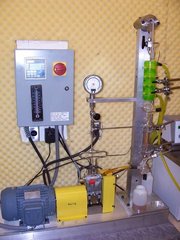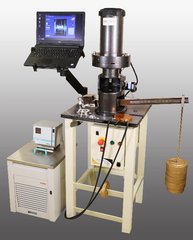Those are high quality base oils and VII’s used in boutique oils.I see Mobil, Castrol and HPL names....but what are the bottom 8 rows on that screenshot?
And what is KRL?
Last edited:
Those are high quality base oils and VII’s used in boutique oils.I see Mobil, Castrol and HPL names....but what are the bottom 8 rows on that screenshot?
And what is KRL?
I agree. Just basing results on the quality of ingredients would be predictable. Amsoil would have done excellent.
IMO it’s amazing how much better an oil with no approval restraints/cost restraints can be.
He points it out in the video, that VI additive has great durability but wrecks the oils cold cranking performance. For the Grp 3 and PAO base it puts the oil out of the 5W spec.Actually, that last sample on the chart, the PAO/PIB combo looks pretty tempting
I see Mobil, Castrol and HPL names....but what are the bottom 8 rows on that screenshot?
And what is KRL?
He points it out in the video, that VI additive has great durability but wrecks the oils cold cranking performance. For the Grp 3 and PAO base it puts the oil out of the 5W spec.
Not great for a year round oil, top notch for a track weekend oil where you don’t care about the cold cranking performance.
Yeah that’s where some in engine testing would be interesting. The Liqui Moly 10W-60 sheered down to a thin 50 weight but a HTHS of 4.7 as you said is still quite high. 50 and 60 weight oils have to have a HTHS above 3.7Great video, I do wish they had tested some higher viscocity boutique blends. All of the ones they tested with ~10 cSt pre KRL, which is interesting, but it would have been interesting to see how a HPL 5w50 does in comparson. While the HTHS shear precentage was higher on say the Mobil 1 5w50 or Moly 10w60, it's HTHS is still higher at the end of the test in absolute terms.
Exactly. The shear-resistance of HPL is well documented, for example, in Wayne’s 30,000 mile run, here:His best video TD. Fantastic and shows why I choose the HPL Euro 5W40 for my Sportwagen and track use with the Star VII and backed by multiple UOAs. In before everything that is coming in this thread.
Many months back when he did a video on PUP, he was so excited about PUP he said he was going to run *that* oil next in his Boxster.interesting he runs the no-VII 30 in his Boxster vs. M1 0W40.
I wonder where this fits in here...HPL has a No VII Euro 10W-40 that might be worth considering.
I noticed they mentioned styrene based VII that shears less than the 5ssi star. I wonder if thats where they added cost comes from? Who knows all i know is i got some supercar 0w40 coming for my ram 1500I wonder where this fits in here...
David Ward's comment that the High Performance Lubricants 0W40 supercar is different and costs more to make vs their Euro/Supercar 5W40.
The obvious presumption in this case with a no compromise philosophy is that more expensive components yield a better performing oil.
I see Mobil, Castrol and HPL names....but what are the bottom 8 rows on that screenshot?
And what is KRL?


Even a 10w is suitable for about 90% of the country for about 90% of the time. In an older engine like the EJ25, 10w really is a year-round oil, and that’s what I would use it for.He points it out in the video, that VI additive has great durability but wrecks the oils cold cranking performance. For the Grp 3 and PAO base it puts the oil out of the 5W spec.
Not great for a year round oil, top notch for a track weekend oil where you don’t care about the cold cranking performance.
KRL testing was what took so long for me to get the gear oil results for the 75w90 thread I made. 11 different oils and just one test took 20 hours for each sample. Sure, the other testing could be done simultaneously, but KRL alone was over a week and a half’s worth of time even if the samples were run around the clock!There is also the Kurt Orbahn Shear stability test.
https://www.savantlab.com/testing-highlights/testing-shear-stability-and-viscosity-loss/
Kurt Orbahn or Bosch Injector
The Kurt Orbahn or Bosch Injector is associated with many methods differing mainly by the number of cycles the lubricant is passed through the injector. This test is designed to mechanically shear the lubricant. The lubricant is sheared when it is passes through a pintle orifice at a pressure of 13 to 18 MPa spraying and atomizing the oil in each pass. It is considered the least severe shearing method of the three discussed here. This method is typically used for engine oils and hydraulic fluids. Savant Labs offer ASTM D6278 Kurt Orbahn Shear Stability, 30 Passes and D7109 Kurt Orbahn Shear Stability, including 30 and 90 Passes. Both tests are ISO/IEC 17025:2005 accredited with this apparatus. Savant can also do custom testing to alter the number of cycles for other similar standards.
KRL (Tapered Roller Bearing)
The KRL shear test uses a tapered rolling bearing in a cup fitted to a four ball instrument. Load is applied to the bearings as they are rotated at a certain RPM for a specified length of time. The test is typically run for 20 hours. KRL is considered to be one of the most severe shear tests and is used for driveline fluids and gear lubricants. The unit can perform standard methods such as CEC L-45-A-99, DIN 51350/6, and ISO 26422:2014. Savant offers CEC L-45-A-99 Modified for KRL testing.
Nope. Dave is just waiting for Lake to stop talking in order to give an explanation.David looks scared while Lake is getting excited!
I wonder where this fits in here...
David Ward's comment that the High Performance Lubricants 0W40 supercar is different and costs more to make vs their Euro/Supercar 5W40.
The obvious presumption in this case with a no compromise philosophy is that more expensive components yield a better performing oil.
